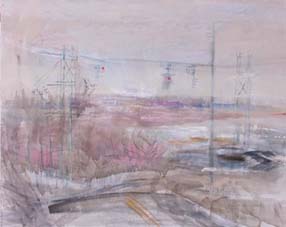|
![]() |
If she is
not exactly an "immortal," like one of
those French Immortals who comprise the Academie Francaise, Anne Poor
of New City, has come within bailing distance of that
exalted appellation -- figuratively speaking, of course. But certainly
as close an any American is likely to come to it in real life. For, you
see, Annie Poor, among this nation's most distinguished artists, has lust
been elected to the American Academy and Institute of Arts and letters,
the American equivalent to the Academie Francaise, founded by Cardinal
Richelieu in 1635 to be protector of the French language and the nation's
cultural heritage, and where the entire body are referred to as "The
immortals."-
So,
Annie Poor's just announced election to the American body is as prestigious
an honor as can be conferred on a creative person in this country;
To understand
this, consider the following:
The Academy-Institute, incorporated by Congress (the Institute in 1913,
the Academy in 1916, with the two merging in 1979) has a combined, and
limited, membership of 250 Americans, each of whom has made notable achievements
in art, literature and music.
In order to be elected, there first must be an opening, either because
of death or resignation. In the arcane way these things happen, no one
knows for certain who will be selected. But he or she must be an American
artist of distinction. No one can apply for membership. Names are selected
by rotating juries of Academy-Institute members and simply announced.
To fill vacancies in its ranks this year, a total of 11, including Poor,
were selected. Among the others announced were: James Rosenquist, painter,
Cy Twombly, painter; Frank Gehry, architect; Renata Adler, critic and
novelist; Robert Bly, poet and translator, Amy Clampitt, poet; Robert
Coover, novelist; Robert Creeley, poet and essayist; Emily Hahn, novelist,
critic and Journalist; and Gary Snyder, poet and translator.
Formal installation ceremonies will not take place until May 20 at the
Academy-Institute's landmark buildings at Audubon Terrace and 155th St.
in New York.
But, as happy is the news that Anne Poor will be inducted into the august
body is the coincidental report that she is to be the
subject of a one-person show at Nyack's Hopper House four days later,
on May 24.
But
more of this at a later date.
Gertrude Dahlberg, widow of Edwin Dahlberg, another of Rockland's great
painters, once wrote of Anne Poor: "Since the death of Edward Hopper
in 1966, the only nationally renowned painter whose earliest roots are
in Rockland is Anne Poor."
|
|
We
should point out that Rockland is also home to many nationally -- and internationally-
known artists like Richard Pousette-Dart,
Sari Dienes, Stephen Greene, Alan Gussow and others. But none, other than
Pousette-Dart, can also claim a famous artist-father, but he lived in Westchester.
Poor's own father was Henry Varnum Poor, who can best be described as painter,
ceramicist, muralist, designer and builder of homes -- the universal man.
He set deep roots in Rockland in the early 1920s, buying property along
fabled South Mountain Road in New City where he designed and built his own
house. He was to do
the same thing a bit later on for his good friend and neighbor, playwright
Maxwell Anderson.
Although Anne Poor was born in New York
City, she was brought to Rockland as a child and has lived continuously
in her father's fine old home, complete with double-thick cinderblock
walls, hand quarried stone fireplaces and other details that give evidence
of the artist's hand at work.
She is, indeed, a Rockland child through and through, having attended
the Street School in New City and, like Edward Hopper, graduating from
Nyack High School.
Early on, her first interest was music. She had hoped to become a concert
pianist. But by the time she was in her teens, both her father and mother
(novelist Bessie Breuer) realized that
she was a born painter.
Annie went on to study at Bennington College and, later, the Arts Students
League, studying with Yasuo Kuniyoshi, Alexander Brook, Morris Kantor
and William Zorach. At home, her father was her mentor, of whom she has
said, "Henry was a great teacher, firmly disciplined, yet very gentle
toward groping young talent."
During World
War II, Annie was a WAAC Corporal, attached to the U.S. Air Force. Her
painting talent came to the fore then when she exhibited at the National
Gallery in Washington -- the only
woman, and a non-commissioned officer at that, in a group show consisting
of four Air Force officers.
And
so it has gone for Anne Poor: a lifetime of painting big things in a muted
and delicate voice.
She paints her favorite places in Maine, the Caribbean, Greece, and most
importantly, in Haverstraw, receiving recognition every
step of the way until, at this moment in her life, Annie might be likened
-- though she would probably urge against it -- to one of
America's "Immortals."
BY MICHAEL,
HITZIG
|
|

